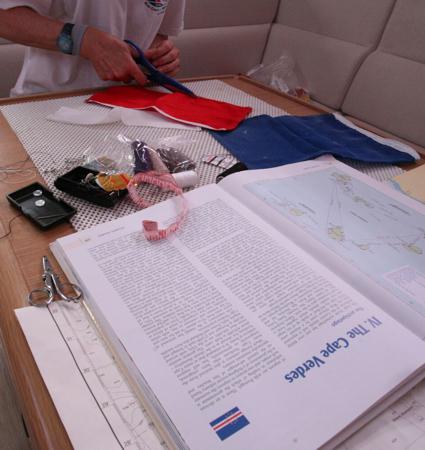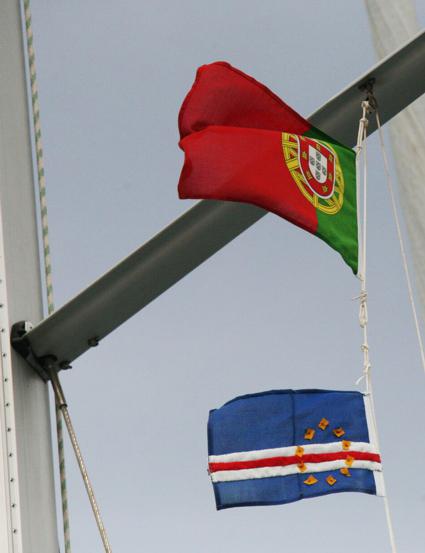Flags - Making and Repairing Flags
Team Jimmy Green are extremely enthusiastic about supplying all the individual courtesy flags that you could possibly need with 212 different world-wide options in stock, combined with the offer to investigate any viable additions.
Customer orders, the larger ones in particular, with their indication of an exciting voyage plan, can set off animated conversation in the Jimmy Green office, sparking admiration and fond reminiscences.
Jimmy Green Marine recommend a thorough check of your flag inventory and a top up of all the possible flags that are missing from your intended voyage plan before setting out from your home berth, whether it’s a hop across the English Channel or a circumnavigation.
Make the most of your preparation for an extended cruise by purchasing your flags well in advance in order to enjoy the anticipation.
Remember that the weather and other circumstances may change your plans en route so it is a good idea to include some contingency flags, just in case.
Team Jimmy Green also recommend gathering some essentials onboard for keeping your flags in good repair and if needs must, for cobbling together any unforeseen omissions that only become apparent once you are at sea.
Flag Repairs
Mending or even making flags is a useful addition to a yacht’s onboard or home-based maintenance programme
A sewing machine and some basic stitching skills will be a big help but not essential for undertaking a tidying up of any frayed hems, small repairs or even a complete flag if the need arises on passage.especially A sewing machine is a useful addition to a yacht’s tool kit inventory, but only if there is room to stow it safely and a member of the crew has the required skills to make it worthwhile.
Machine sewing will significantly save time and probably ensure that the stitching is more regular and generally neater.
However, on extended passage and for live-aboard cruisers, time is usually not an issue, so an onboard flag-making and repair kit may pay for itself over a shorter time span than you expect, with or without a machine.
A member of your crew may already have a domestic sewing kit for the occasional extra stitching or patch required on clothing but make sure that the needles are suitable for the potentially, slightly heavier duty requirement.
All sewing threads for hand and machine stitching in a marine environment should be polyester for strength, durability and UV resistance.
True anecdote – On the ARC Plus Rally from Las Palmas on Gran Canaria to Mindelo, São Vicente, a skipper and crew, while preparing for the next day’s landfall, realised to their dismay that they couldn’t find their Cape Verde Courtesy Flag. A handy crew member had a stitch kit, the aptitude and the enthusiasm to set aside the little time left, in order to make a substitute. With no flag fabric or other flag making spares to turn to, she unpicked the hoist reinforcement of a half yard French courtesy flag, cut the new red, white and blue horizontal stripes from the tricolour and stitched it all back together with the same hoist line to form the basis of a smaller 12” x 8” courtesy flag. The next step was a little fiddly, cutting out the yellow stars from a spare Q flag, and sewing them on to complete a temporary substitute. The resulting, onboard, on-passage Cape Verde Courtesy flag was a little smaller than desirable, certainly not perfect, but gloriously passed muster at the spreaders for the duration of the stopover (about 5 days) in a very windy Mindelo before departing for Saint Lucia.



Imagine what could be achieved with a comprehensive swatch of flag fabric in all colours, some hoist tape, some braided cord (already an essential part of the onboard rigging spares inventory) or flag toggles/eyelets if preferred, some sturdy polyester sewing thread, a pair of sharp fabric scissors and some sewing needles.
As mentioned above, a sewing machine will help on more adventurous projects.
Some small printed union designs would also be a very helpful addition to the spares kit.
The courtesy flags of many British Crown Dependencies and Overseas Territories are blue or red ensigns with additional emblems or coats of arms. These all have the same union design in the Canton (top left quadrant next to the hoist).
A physical courtesy flag reference library is advisable before you leave port e.g. a suitable almanac or cruising guide, a comprehensive flag book, a saved or printed download from
Jimmy Green Courtesy Flags ~ unless of course the yacht will have access to the internet while at sea.
Tackling the finicky detail e.g. stars, complex motifs, crests and badges requires an imaginative approach.
Stars and moons can be painstakingly cut out and sewn on with appliqué technique but the smaller detail and the artwork will almost certainly require an alternative method.
Trial and error on fabric offcuts will help to settle on the best process and craft materials for each aspect of the various emblems.
Remember that the flag only needs to look right from a distance. The closest view will be from your own deck or the next-door yacht on a pontoon, to the hoisted height just below the mast spreaders.
Your creative handiwork will also need to stand the test of time in a harsh marine environment, so it is important to choose the best quality, most weatherproof arts and crafts products for finishing complicated flags.
Suggested solutions include fabric paint, indelible ink markers, ready-made sew-on fabric shapes but please note that none of these are recommended from first hand experience.
It is much more enjoyable to own the correct courtesy flags and look forward to flying the correct one with pride as you sail into a new anchorage.
The onboard reserves can serve as a last-ditch resort or as support for a sustainable ‘make do and mend’ policy.
Jimmy Green Marine stock the major component materials for making and repairing flags.













